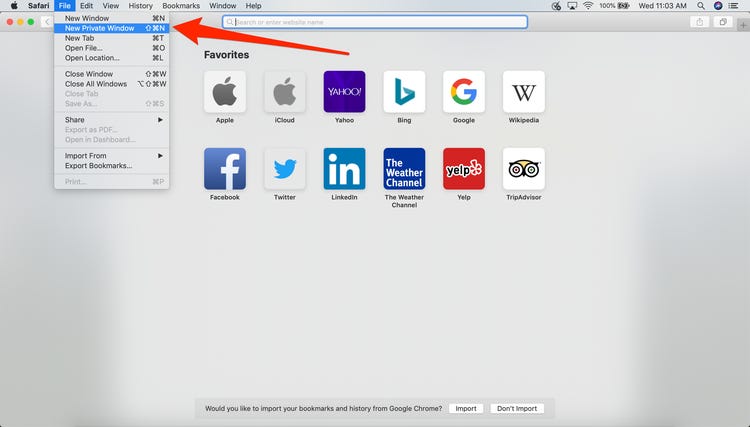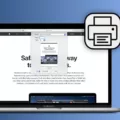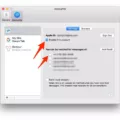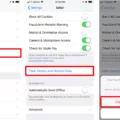Incognito mode, also known as private browsing, is a great way to browse the web securely and privately on your Mac. It ensures that no trace of your online activities is left behind on your computer. This is especially helpful for those who are concerned about their online privacy or want to prevent othes from seeing what websites they have visited recently.
When you enable incognito mode in Safari on your Mac, all history, cookies, and other website data are erased automatically when you close the browser window. This means that no one can track your activities or access any data stored by websites while using Safari in Incognito mode. Additionally, it helps to keep searches and downloads separate from one another so that they don’t mix up with each other.
To enable incognito mode on Mac, open Safari and click “File” in the top menu bar followed by “New Private Window” or you can use the keyboard shortcut Shift + Command + N. Once you have enabled private browsing, a dark Smart Search field with white text will appear at the top of the window indicating that you are now in incognito mode. While in this mode, any website that you visit will not be stored in your browsing history or be accessible throgh autofill or autocomplete options.
One important thing to remember when using Incognito mode is that it does not offer complete privacy protection since some data may stll be visible to ISPs (Internet Service Providers) or employers who monitor network traffic. It also does not prevent malicious software from tracking your activities online. Therefore, it is important to use caution when browsing the web while in Incognito mode and ensure that you have up-to-date anti-virus software installed on your computer for added protection against malware and other cyber threats.

Activating Incognito Mode on a Mac
To enter incognito mode on a Mac, open the Safari browser and select File > New Private Window. This will open a private window with a dark Smart Search bar at the top. With this window open, you can browse the web as you normally would, but your activity won’t be tracked or stored in any way. You won’t leave any cookies or other traces bhind either, so your browsing activity remains completely private and secure.
Using Incognito Mode in Safari on Mac
Yes, there is an incognito mode for Safari on Mac. To enable it, open Safari and select File from the top menu bar, then choose New Private Window. Alternatively, you can use the keyboard shortcut Shift + Command + N to open a new Private Browsing window. This will prevent websites from saving your browsing history and other private data such as cookies. Additionally, this mode also prevents any automatically filled in forms or passwords from being saved.
Turning On Incognito Mode in Safari
To turn on Incognito Mode in Safari, open Safari on your iPhone or iPod touch. Then tap the Tabs button, followed by the [number] Tabs option to open the Tab Groups list. Tap Private and then tap Done. This will enable Incognito Mode, which prevents Safari from storing information about sites you visit and blocks some websites from tracking your activity.
Unable to Open an Incognito Window in Chrome on Mac
There could be a few reasons why you’re unable to open an Incognito window in Chrome Mac. First, make sure that you have the latest version of Google Chrome installed on your Mac. It’s possible that there might be a bug or compatibility issue with an old version of the browser. You can check for updates by clicking on the three-dot menu in Chrome followed by Help and then About Google Chrome. If an update is available, it will be downloaded and installed automatically.
Another possibility is that your Incognito mode may have been disabled by the administrator in your organization or institution. In this case, contact them for assistance to enable the feature.
Finally, if none of these steps work, resetting your browser settings back to their original defaults may help. To do this, open Chrome and click on the three-dot menu folowed by Settings. Next, click on Reset and clean up followed by Restore settings to their original defaults. Click Reset settings and then try to enter the incognito mode to see if it works.
Using Chrome Incognito Mode
Using Chrome incognito mode is a great way to browse the web without leaving any trace of your activity. To open an Incognito window, you can use the keyboard shortcut combination Ctrl-Shift-N (Windows) or Command-Shift-N (macOS). Alternatively, you can click the menu icon (the three vertical dots in the top right corner) and select New Incognito Window from the list. Once an Incognito window is opened, any activity within it will not be stored on your computer. This includes web pages visited, as well as any cookies or othr website data. It’s also important to note that while Chrome’s Incognito mode stops your activity from being stored on your computer, it doesn’t hide your identity online and won’t protect you from being tracked by websites or services that you visit.
The Safety of Safari’s Incognito Mode
No, Safari’s Incognito mode is not completely safe. It won’t protect you from all online threats. Your IP address is still visible to third parties, and your browsing activity can be tracked by your internet service provider and other sites you visit. Additionally, any files you download or bookmarks you make will be stored on your computer, so if someone else has access to your device they could see this information. For maximum security, consider using a Virtual Private Network (VPN) to protect your privacy online.
Conclusion
In conclusion, Incognito mode on Mac is a great way to browse the web securely and privately. It prevents websites from tracking your activity and prevents any data from beng stored on your device. Incognito mode can be enabled in Safari by selecting File > New Private Window or using the keyboard shortcut Shift + Command + N. Once enabled, you can browse as you normally would without leaving a trace of your activity behind. It’s important to remember that your browsing activity may still be visible to your internet service provider and other third-party services, so it’s not a guarantee of true privacy.








